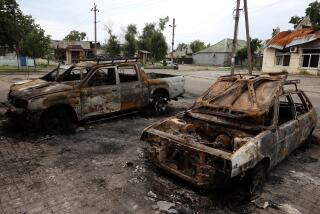U.S.-Soviet Thaw Has a Chilling Effect on Town
- Share via
FLORENNES, Belgium — Construction on the 650-unit U.S. housing project has suddenly come to a halt, and Mayor Louis Timmermans will have to build the new sewers out of his municipal budget.
Renaud Henet, who runs Le Manhattan Cafe, said it looks like the U.S. Air Force personnel who stopped in regularly for a drink will have to leave just as they were starting to learn a little French.
Claudine Constant, who has rented her apartment to six American families in a row, refuses to believe the U.S. military will pull out of this bleak little town in the southern Belgian Ardennes region, insisting that something new is bound to come along to keep them and their rent dollars around.
Under terms of the U.S.-Soviet nuclear disarmament treaty signed Dec. 8 in Washington, however, the Tomahawk cruise missiles assigned to the 1,300-man 485th Tactical Missile Wing at Florennes Air Base will have to be eliminated over the next three years.
Major Arms Control Step
The treaty, which will shut down missile sites in four other Western European countries as well, has been hailed as a major step in arms control and a reward for the decision to deploy cruise missiles in Western Europe despite vociferous objections from anti-nuclear peace organizations in the early 1980s.
Florennes has had more than its share of demonstrations since the first 16 missiles arrived here in the spring of 1985, the initial step in Belgium’s planned total deployment of 48 by 1990.
But as the process reaches its culmination and the missiles are slated for destruction, the 4,000 residents of this farming town seem far removed from the triumphant diplomacy of Washington or the grand debates of Brussels.
In Florennes, where unemployment is running at 24% and the regional economy is flagging, people are thinking instead about lost income.
110 Jobs Threatened
“We thought the missile deployment would maybe get this region moving again,” Henet said. “Now people say the Americans are going to leave. Some people are not going to have it so good any more. A lot of money was allocated for that, and it made things flow. But I guess that’s going to stop now.”
Timmermans calculated that 110 local people could lose their jobs if the base is eliminated entirely rather than being altered for another use. But the overall economic repercussions will reach much wider, he said.
“That guy who just knocked on the door,” he gestured toward the entrance to his town hall office, “he runs a gasoline station. Ask him how much he sells to the Americans. There are a lot of people like that.”
About $125 million was allocated for building the missile installations and support facilities that have risen just out of town. U.S. funds and the infrastructure fund of the North Atlantic Treaty Organization, to which Belgium contributes 4.59%, financed the work, which lacks only for the housing.
Apart From Noisy Debates
Timmermans said that deploying the missiles was politically wise for the West and beneficial for his town. Florennes never really participated in the noisy debates over deploying the missiles, because people here “don’t give a tinker’s damn about it,” he said.
“I facilitated the entry of the missiles here because the people are for it,” he said. “I’ll give you 1,000 francs if you can go out in the street and find three people who will come here and tell me they are against the missiles.”
If the people of Florennes mostly took nuclear missiles in their stride, it is perhaps because they have a long history of ties to the military. The town was founded by medieval lords as a fortified stronghold. Later, young men from the Florennes region joined Napoleon’s army until he met his Waterloo just 30 miles to the northwest.
The air base, which also houses Belgian Air Force Mirage 5s, was begun by Nazi Germany in 1942. It was taken by the U.S. Army in 1944, and P-38 Lightnings took off from here to provide air cover during the Battle of the Bulge.
The Belgian military took it over in 1947. But troops of other NATO nations have been stationed here periodically since then and local residents have grown used to the whine of fighters.
Used to Foreign Troops
“We have always had foreign troops here--German, French, English, American,” Timmermans said. “It was the Germans who built the base in the first place.”
Wilfried Martens, who has been prime minister with a center-right coalition during most of the missile controversy, went ahead slowly with the deployment, which actually began in 1985.
The anti-missile vote has been symbolized by a house, just opposite the U.S. entrance to the base, in which young anti-nuclear activists have installed an anti-missile headquarters baptized Florennade. As the treaty to eliminate the missiles was being signed in Washington, about 60 activists from several European countries met there to chart the movement’s future.
Jean-Michel Caron, one of six persons still living in the house, said that large-scale demonstrations are no longer possible for lack of public interest. The missile issue was largely missing in Belgian legislative elections in December.
The peace group, instead, will try to photograph movements of the missiles between now and their removal, expected in 1989, Caron said.
More to Read
Sign up for Essential California
The most important California stories and recommendations in your inbox every morning.
You may occasionally receive promotional content from the Los Angeles Times.











